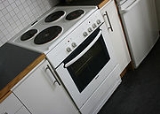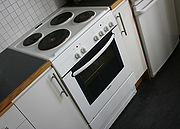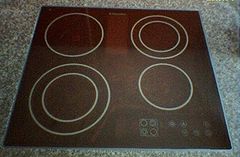
Electric stove
Encyclopedia

Electricity
Electricity is a general term encompassing a variety of phenomena resulting from the presence and flow of electric charge. These include many easily recognizable phenomena, such as lightning, static electricity, and the flow of electrical current in an electrical wire...
into heat
Heat
In physics and thermodynamics, heat is energy transferred from one body, region, or thermodynamic system to another due to thermal contact or thermal radiation when the systems are at different temperatures. It is often described as one of the fundamental processes of energy transfer between...
to cook
Cooking
Cooking is the process of preparing food by use of heat. Cooking techniques and ingredients vary widely across the world, reflecting unique environmental, economic, and cultural traditions. Cooks themselves also vary widely in skill and training...
and bake
Baking
Baking is the technique of prolonged cooking of food by dry heat acting by convection, and not by radiation, normally in an oven, but also in hot ashes, or on hot stones. It is primarily used for the preparation of bread, cakes, pastries and pies, tarts, quiches, cookies and crackers. Such items...
.
History
On September 20, 1859, George B. Simpson was awarded US patent #25532 for an 'electro-heater' surface heated by an platinum-wire coil powered by batteries; in his words, useful to "warm rooms, boil water, cook victuals...".Canadian inventor Thomas Ahearn
Thomas Ahearn
Thomas Ahearn, PC was a Canadian inventor and businessman. Ahearn, a native of Ottawa, was instrumental in the success a vast streetcar system that was once in Ottawa, the Ottawa Electric Railway, and was the first chairman of Canada's Federal District Commission in 1927...
filed patent number no. 39916 in 1892 for an "Electric Oven," a device he likely employed in preparing a meal for an Ottawa
Ottawa
Ottawa is the capital of Canada, the second largest city in the Province of Ontario, and the fourth largest city in the country. The city is located on the south bank of the Ottawa River in the eastern portion of Southern Ontario...
hotel that year. Ahearn and Warren Y. Soper were owners of Ottawa's Chaudiere Electric Light and Power Company. The electric stove was showcased at the Chicago World's Fair
World's Columbian Exposition
The World's Columbian Exposition was a World's Fair held in Chicago in 1893 to celebrate the 400th anniversary of Christopher Columbus's arrival in the New World in 1492. Chicago bested New York City; Washington, D.C.; and St...
in 1893, where an electrified model kitchen was shown. Unlike the gas stove, the electrical stove was slow to catch on, partly due to the unfamiliar technology, and the need for cities and towns to be electrified. By the 1930s, the technology had matured and the electrical stove slowly began to replace the gas stove
Gas stove
In cooking, a gas stove is a cooker which uses natural gas, propane, butane, liquefied petroleum gas or other flammable gas as a fuel source.-History:...
, especially in household kitchens.
In 1897, William Hadaway was granted US patent # 574537 for an "Automatically Controlled Electric Oven".
Kalgoorlie Stove
In November 1905, David Curle Smith, the Municipal Electrical Engineer of Kalgoorlie, Western Australia, applied for a stove patent (Aust Patent No 4699/05) for a device that adopted what became the standard configuration of electric stoves: that is, an oven surmounted by a hotplate with a grill tray between them. Curle Smith's stove did not have a thermostat, but heat was controlled by however many of the appliance’s nine elements were switched on.In October 1906, Curle Smith commenced manufacturing stoves to be hired out by the Kalgoorlie Municipality. About 50 appliances were produced before cost overruns became a factor in Council politics and the project was suspended. This seems to have been the first time household electric stoves were produced with the express purpose of bringing "cooking by electricity ... within the reach of anyone".
To promote the stove, David Curle Smith's wife, Helen Nora, wrote a cookbook containing operating instructions and 161 recipes. Thermo-Electrical Cooking Made Easy, published in March 1907, is therefore the world's first electric stove cookbook.
Variants

Resistor
A linear resistor is a linear, passive two-terminal electrical component that implements electrical resistance as a circuit element.The current through a resistor is in direct proportion to the voltage across the resistor's terminals. Thus, the ratio of the voltage applied across a resistor's...
heating coils which heated iron hotplates, on top of which the pots were placed.
In the 1970s, glass-ceramic
Glass-ceramic
Glass-ceramics are polycrystalline material produced through controlled crystallization of base glass. Glass-ceramic materials share many properties with both glasses and ceramics...
cooktops started to appear. Glass-ceramic has very low thermal conductivity
Thermal conductivity
In physics, thermal conductivity, k, is the property of a material's ability to conduct heat. It appears primarily in Fourier's Law for heat conduction....
, a coefficient of thermal expansion of practically zero, but lets infrared
Infrared
Infrared light is electromagnetic radiation with a wavelength longer than that of visible light, measured from the nominal edge of visible red light at 0.74 micrometres , and extending conventionally to 300 µm...
radiation pass very well. Electrical heating coils or infrared halogen
Halogen
The halogens or halogen elements are a series of nonmetal elements from Group 17 IUPAC Style of the periodic table, comprising fluorine , chlorine , bromine , iodine , and astatine...
lamps are used as heating element
Heating element
A heating element converts electricity into heat through the process of Joule heating. Electric current through the element encounters resistance, resulting in heating of the element....
s. Because of its physical characteristics, the cooktop heats more quickly, less afterheat remains, and only the plate heats up while the adjacent surface remains cool. Also, these cooktops have a smooth surface and are thus easier to clean, but they only work with flat-bottomed cookware and are markedly more expensive.
A third technology—developed first for professional kitchens, but today also entering the domestic market—is induction stoves
Induction cooker
An induction cooker uses induction heating for cooking. Unlike other forms of cooking, heat is generated directly in the pot or pan , as opposed to being generated in the stovetop by electrical coils or burning gas...
. These heat the cookware directly through electromagnetic induction
Electromagnetic induction
Electromagnetic induction is the production of an electric current across a conductor moving through a magnetic field. It underlies the operation of generators, transformers, induction motors, electric motors, synchronous motors, and solenoids....
and thus require pots and pans with ferromagnetic bottoms. Induction stoves also often have a glass-ceramic surface. Electric stoves are very popular today, especially in urban and suburban areas.

